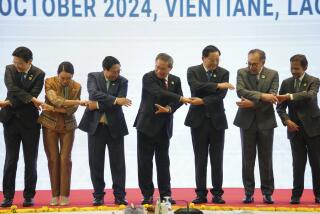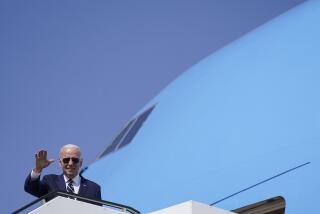China’s Widening Footprint Prompts Trepidation
LUANG NAM THA, Laos — From daybreak till past nightfall, Xu Ximing is on the move, rushing between his potato farm, rubber plantation, fish ponds and orange grove.
The Chinese migrant’s enterprising ways contrast sharply with the languid lifestyle of his Lao neighbors. He hires them to work his fields.
“Rent and labor [are] cheaper than in China,” the farmer said before scampering off to inspect a burst irrigation dike and shout at locals to stop trampling through his potato patch.
Xu, 60, moved to Laos with six family members, joining in a swelling stream of Chinese drifting southward into Southeast Asia in search of economic opportunities, more elbow room and fewer restrictions.
Brick-makers, scrap-metal dealers, ice cream vendors, road-builders and farmers are sinking roots in northern Laos. Some frontier areas of Myanmar could easily be mistaken for China, with only the yuan currency and Chinese language in use. Deeper in Southeast Asia, illegal migrants filter into northern Thailand and set up restaurants and health clinics in Cambodia.
Although hardly a mass migration, the inflow is among factors awakening fears that China -- now the world’s No. 3 economy -- may come to dominate the region, exacting obedience and tributes from its southern neighbors much as Beijing’s emperors demanded in centuries past.
“If the present trajectory is maintained, we are looking to the time when China is by a long chalk going to be the most influential country in the region, and it’s going to be hard not to do what China says,” said Hugh White, director of the Australian Strategic Policy Institute.
But for the midterm, he and others describe a less insidious scenario.
“Fear is always there when you are sitting next to a giant. But this is somewhat being replaced by a kind of hope, a belief that China will not be as foolish to behave like a big elephant in Southeast Asia,” said Sheng Lijun of Singapore’s Institute of Southeast Asian Studies.
The official line from the region’s capitals is that China presents more opportunities than threats. And if Beijing does assume the mantle of Big Brother, he’ll prove a benign one.
“China is today a creator of prosperity of the highest order. Political and social linkages are bound to eventually follow suit. It is therefore important to use every opportunity and establish ties,” Malaysian Prime Minister Abdullah Ahmad Badawi said.
Optimists like Abdullah note that Southeast Asia is “feeding the dragon” with exports ranging from shrimp to natural gas and paper pulp, ringing up an $8-billion trade surplus with China.
Businesses in Singapore reap profits by helping Chinese firms raise foreign capital and go international. In Cambodia, Beijing provides aid to the military and Chinese-language schools. Chinese tourists are spending in ever-increasing numbers.
Analysts agree that trade and economic issues are intertwined with China’s increasingly ambitious political and security aims.
Once reluctant to get involved, Beijing since the late 1990s has come to regard multilateral ties as “instruments of Chinese diplomacy,” White said.
Beijing is at the forefront of such landmark efforts as the Free Trade Area to span China and Southeast Asia by 2010 and development of the Mekong River basin. Chinese leaders visiting the region’s capitals are accorded pomp and deference.
Jonathan Adelman, a University of Denver China expert, says Beijing’s leaders are homing in on Southeast Asia because it’s not locked into the continent’s other major power nodes -- Japan, India and the Russian Far East. “It’s logical for them to expand not only economically but politically and even culturally and to feel that this is their natural home,” he said.
On the economic front, China is inflicting some losses on its southern neighbors, fueling resentment. China not infrequently wins the competition for foreign investment, and multinational companies are increasingly shifting manufacturing to China. Electronics components once made in Malaysia and Indonesia are being produced in Chinese industrial zones that also churn out a flood of cheap goods displacing homemade equivalents in Southeast Asia.
Lao carpenters grouse that the Chinese craft better and cheaper furniture, one of this impoverished country’s few viable exports. In Laos’ capital, Vientiane, the Thai-made motorcycles that once filled the streets have all but vanished, replaced by Chinese models selling for about one-third the price.
Sheng and others see a “win-win” era lasting five to 10 years or more during which China promotes a stable security environment in Asia to allow its own economic growth to roll on. Beijing in turn will dole out economic benefits to Southeast Asians, storing up goodwill that it can call upon if China faces future confrontation with the United States or others.
Peking University’s Institute of International Relations recently suggested that China might hark back to the tributary system conceived under the Ming Dynasty, founded in the 14th century, to ensure a circle of stability around the Middle Kingdom. Under this, China regarded itself as the very heart of the region from which meticulously calculated tributes were mandated. For example, Thailand, then known as Siam, sent ivory every four years, while Myanmar shipped precious stones every decade. In return, China’s emperors bestowed favors, in principle more generous than they received.
Meanwhile, the push south proceeds, with a network of roads, river ways and air links being forged or planned that will give China -- particularly its southern province of Yunnan -- greater and speedier access to Southeast Asia and beyond.
The once sleepy northern Thai town of Chiang Saen has been converted into a buzzing Mekong River port to accommodate the burgeoning trade with China. Recently, hundreds of workers clambered up the steep riverbank, hauling crates of apples and pears from a Chinese barge. These were rapidly loaded onto trucks bound for destinations as distant as Singapore.
Up the road, Thais funneled through a border checkpoint into the town of Tachileik in Myanmar to stock up on everything from dried mushrooms to panties, toys and fake compact discs, all Chinese-made.
In northern Laos, Xu the entrepreneurial farmer is pleased that a paved road will run past his fields in a few years, allowing him to easily truck potatoes to Thailand and China. The 152-mile corridor will cut through Laos between the Chinese border town of Boten and Huay Sai on the Thai frontier.
But his enthusiasm is anything but unanimous. Many Lao privately express anxiety over China’s immense power, their own weaknesses and a population lineup of 5.3 million countrymen to 1.3 billion Chinese.
In an often-heard remark, they lament: “Laos is empty; China is full -- and recently a couple of leaks have sprung up at the bottom end of China.”
More to Read
Sign up for Essential California
The most important California stories and recommendations in your inbox every morning.
You may occasionally receive promotional content from the Los Angeles Times.










